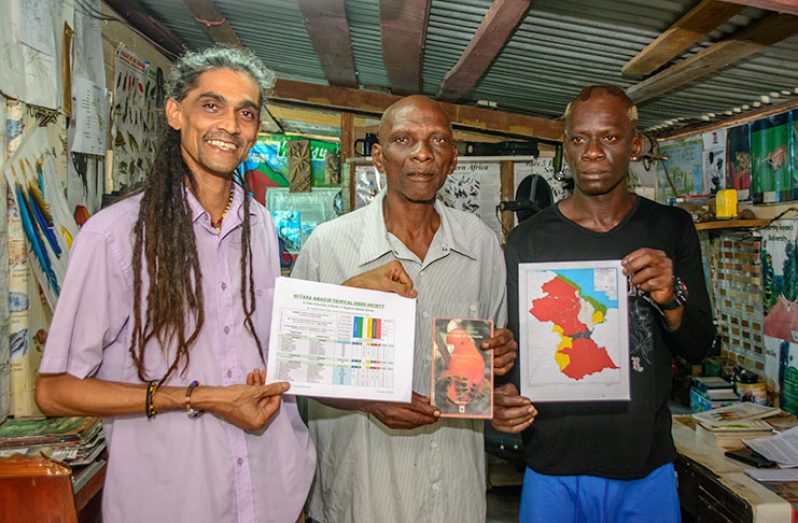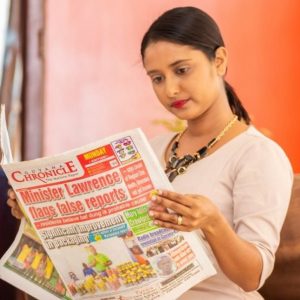SIXTEEN years ago, bird lover Andy Narine returned from Guyana’s remote interior where he

worked as a field assistant with experts from Smithsonian.
They were some of the best United States based scientists in ornithology (the scientific study of birds) and they were especially interested in reaching the pinnacle points of Guyana during their research.
And so year after year, beginning around 1995, Andy would trek through the most remote areas of Guyana with the group. When he returned to the city though, an idea occurred to him, especially as he observed the many single-parent families along the Lamaha Railway Embankment. He was living in Light Street, Alberttown, and a stone’s throw away from the embankment.
“Why not gather these kids and teach them something? Why not form a bird society with them?” thought Andy. This idea became very appealing because it occurred to him that the group he worked with focused mainly on the peak areas.

“I realized that we could do the areas that everybody walked passed. Most researchers want to go to the high mountains and the remote parts of the jungle, but on the coastal parts and the flatland, no one was actually doing anything.”
With just about 15 youths from his neighbourhood, Andy began the Guyana Amazon Tropical Bird Society (GATBS) which would eventually grow to have some 162 members scattered all across Guyana. This is notwithstanding that the society lost many of its members when the government distributed house lots to those persons on the embankment.
“They (the youths) are the ones who helped us form the society. We would have sessions with them each day and I would take them to the gardens to view the birds. If you go to the Botanical Gardens, you can see as many as 50 different species of birds in two hours. And we would also go across Guyana and conduct inventories,” he fondly recalled during an interview at the society, Light Street, Alberttown, Georgetown.
The Environmental Protection Agency (EPA) heard about Andy’s great work and gifted the society $172,000 which was used to buy 10 pairs of binoculars. “We took these kids so that they won’t be hanging in the wrong place in the evening, and so they could be a part of something.”
Andy has since found that many of the young people whom he took under his wings have turned out to be tour operators, tour guides and so forth. “Our greatest achievement in the society has been to help people establish themselves,” says Andy.
Andy, whose inspiration for birding comes from David Finch of from Wings International, started the society as an at-risk youth programme but it became a national programme instead because he ended up forming a society to protect the birds in Guyana.
“We proposed to the Friendly Societies Act at the Human Services Ministry and in 2005, we got a certificate from them as a special authorized society. For a number of years, we have been mapping Guyana, doing a water bird census in important bird areas.” The society has also been working along with Bird Life International and Wetlands International, among other organisations.
Taking on the challenge to list the birds in Guyana, Andy and his team found that the birds were restricted to their habitats, which contain certain bird species that won’t be found overlapping in other habitats.
Dorothy E. Snyder had built Guyana’s first checklist in 1966 with the 720 bird species that she found. Today, 50 years later, Andy and his team has found a whopping 910 species.
Printing the Checklist
Andy explained that 910 bird species on the Guyana checklist were noted by the society, not only to help educate the tourism sector but to help the local tour guides who may have to answer questions about bird species from tourists. “These individuals can be able to tell a tourist exactly where in the country to find a particular bird.”
The society has since put together a 25-page document on ornithology, which along with the checklist will assist the school’s curriculum.
A proposal was worked out with the Ministry of Natural Resources to get this information printed. “So we are waiting for the board to meet so that we can get support to print 500,000 copies for the schools.”
The ministry has since written to the society putting it on hold. “Our number one tourism product in Guyana is bird watching and we recognize that we need to have our checklist out for the tourism sector, so we are looking to the general public and the private sector to look into the society.
“The tourists need the list so that as they travel across Guyana, they can tick off the birds they see. So the list is vital right now. We recognize that we need to wait on the ministry to put that board together to have the list in schools. But in the time we are waiting, we are looking to print the checklist for the tourism sector because next month is Guyana Tourism Month,” expressed Andy.
He is hoping that the private sector would lend its support to the initiative since this data can also serve to boost their marketing strategy. “The checklist is growing because we still need to reach into areas we have never gone into before. So there’s still a lot of work to do. Having the checklist would be able to boost Guyana’s birding tourism. We just can’t put 900 birds in a magazine and there is no such thing as that list. Without that list printed, our society, which is run on a voluntary basis, is being stagnated.”
Plenty Ground Work
Today, the society works hard to produce vital birding information to anyone who may be interested such as the private sector, and university and school students. At times, the private sector would hire the society to go out and do a special inventory.
“Today, you could go to any resort in Guyana and find a bird book thanks to the bird society. The society has reached out, and as a result has developed a network across the 10 regions of Guyana. It is now an important database center in the country.
“A lot of people don’t respect the work that people put out in Guyana and we non-governmental organisations are doing a lot of the ground work. But there’s supposed to be a benefit at the end of the day.”
The space in which Andy and his team operate is definitely not conducive to the amount of work that they do on a daily basis. “So we want a building with more space so as to get more people involved and more things done. Our database also needs a bit of strengthening and support for the data we have been gathering over the last 15 years.
The society also has a foster bird programme where injured birds can be taken there by anyone and the team would help the bird recuperate using natural medicine that is grown there.
Last year, someone stole three toucan chicks from the bird sanctuary in the Botanical Gardens and it was Narine and team who worked tirelessly to get them back. Today, the birds are as healthy as ever, being nursed back to good health at the society.
The public can call the society on 225 2190, or send an email to gatbs@yahoo.com. It is also opened to the public between 9 am and 3 pm on a daily basis.




.png)









